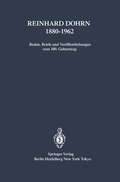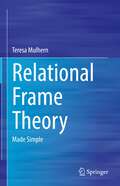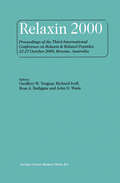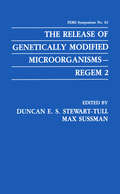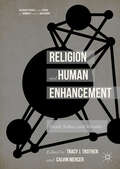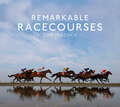- Table View
- List View
Reindeer 2 (UEB uncontracted)
by Adrian FarnsworthThis page shows a Large Print image of one of Santa's reindeer helpers seen from the side and facing to the left.
Reindeer and Caribou: Health and Disease
by Morten Tryland Susan KutzThis book is a comprehensive presentation of health and diseases in reindeer and caribou, or just Rangifer, a key Circumarctic species with broad social and ecological value. It is an essential reference for anyone interested in the biology and health of wild or semi-domesticated reindeer and caribou, and is more broadly relevant for those with interests in other species of free-ranging and captive cervids. Beginning with a general introduction to Rangifer as a species, it then focuses on Rangifer "health" as a concept and describes the determinants of health at an individual and population level. Chapters cover a range of topics from nutrition and feeding to stress, non-infectious and infectious diseases, meat hygiene, capture and restraint, diagnosis and treatment of health issues, and finally, potential impacts of climate change on health of Rangifer. Reindeer and Caribou: Health and Disease compiles extensive research and experience-based information on issues ranging from drug doses for chemical immobilization, blood chemistry values, and raising an orphaned calf. In addition, it contains hundreds of high quality colour illustrations that contribute to its value as a diagnostic resource for recognizing various parasites, pathogens and signs of disease, both in live and dead animals. Each chapter is followed by a comprehensive list of references and a list of contact information for all the contributors, identifying world experts in the different areas of health for this circumpolar and fascinating species. This book is compulsory reading and an indispensable resource for anyone dealing with health in reindeer and caribou, including veterinarians, wildlife biologists and managers, reindeer herders/game ranchers, zoological husbandry personnel, and students with wildlife health.
Reindeer and Caribou: Health and Disease
by Morten Tryland Susan J. KutzThis book is a comprehensive presentation of health and diseases in reindeer and caribou, or just Rangifer, a key Circumarctic species with broad social and ecological value. It is an essential reference for anyone interested in the biology and health of wild or semi-domesticated reindeer and caribou, and is more broadly relevant for those with interests in other species of free-ranging and captive cervids. Beginning with a general introduction to Rangifer as a species, it then focuses on Rangifer "health" as a concept and describes the determinants of health at an individual and population level. Chapters cover a range of topics from nutrition and feeding to stress, non-infectious and infectious diseases, meat hygiene, capture and restraint, diagnosis and treatment of health issues, and finally, potential impacts of climate change on health of Rangifer. Reindeer and Caribou: Health and Disease compiles extensive research and experience-based information on issues ranging from drug doses for chemical immobilization, blood chemistry values, and raising an orphaned calf. In addition, it contains hundreds of high quality colour illustrations that contribute to its value as a diagnostic resource for recognizing various parasites, pathogens and signs of disease, both in live and dead animals. Each chapter is followed by a comprehensive list of references and a list of contact information for all the contributors, identifying world experts in the different areas of health for this circumpolar and fascinating species. This book is compulsory reading and an indispensable resource for anyone dealing with health in reindeer and caribou, including veterinarians, wildlife biologists and managers, reindeer herders/game ranchers, zoological husbandry personnel, and students with wildlife health.
The Reindeer Games
by Zander DowieEveryone can name Santa's Reindeer, but how did they earn their place guiding his sleigh? Santa Claus needs to replace his two ageing reindeer, Leo and Flora, or Christmas will be cancelled! Reindeer from all over the world head to the North Pole to compete in The Reindeer Games - a series of mental and physical challenges to determine who earns a place guiding Santa's sleigh. Told through the eyes of Skye, a teenage reindeer from the famous MacDonald herd in Scotland, the competing Reindeer will test more than just their skills in physical and mental fitness. They must overcome self-doubt, inner fears and harness their inner child.
Reindeer Hunters of the Ice Age in Europe: Economy, Ecology, and the Annual Nomadic Cycle
by Laure FontanaThis book undertakes a thorough study of Reindeer in the Upper Pleniglacial and Tardiglacial societies in France. It addresses two main topics – the economy of animal resources within the societies and the exploitation of Reindeer organized within the annual cycle, in terms of space and time, between 30,000 and 14,000 cal BP in France. The author proposes an analysis and hypothesis regarding the economy of animal resources and the nomadic cycle of the last Paleolithic hunter-gatherer societies, in order to identify a “Reindeer system.”The author discusses the relationship between Reindeer and human mobility and offers some conclusions regarding the annual cycles of nomadism. The volume scrutinizes the distinct eco systems in three regions and its effects on the movements of both human and animal. This book is of interest to zooarchaeologists and prehistorians.
Reindeer Husbandry and Global Environmental Change: Pastoralism in Fennoscandia (Earthscan Studies in Natural Resource Management)
by Tim HorstkotteThis volume offers a holistic understanding of the environmental and societal challenges that affect reindeer husbandry in Fennoscandia today. Reindeer husbandry is a livelihood with a long traditional heritage and cultural importance. Like many other pastoral societies, reindeer herders are confronted with significant challenges. Covering Norway, Sweden and Finland – three countries with many differences and similarities – this volume examines how reindeer husbandry is affected by and responds to global environmental change and resource extraction in boreal and arctic social-ecological systems. Beginning with an historical overview of reindeer husbandry, the volume analyses the realities of the present from different perspectives and disciplines. Genetics, behavioural ecology of reindeer, other forms of land use, pastoralists’ norms and knowledge, bio-economy and governance structures all set the stage for the complex internal and externally imposed dynamics within reindeer husbandry. In-depth analyses are devoted to particularly urgent challenges, such as land-use conflicts, climate change and predation, identified as having a high potential to shape the future pathways of the pastoral identity and productivity. These futures, with their risks and opportunities, are explored in the final section, offering a synthesis of the comparative approach between the three countries that runs as a recurring theme through the book. With its richness and depth, this volume contributes significantly to the understanding of the substantial impacts on pastoralist communities in northernmost Europe today, while highlighting viable pathways to maintaining reindeer husbandry for the future. This book will be of great interest to students and scholars of both the natural and social sciences who work on natural resource management, global environmental change, pastoralism, ecology, social-ecological systems, rangeland management and Indigenous studies.
Reindeer Husbandry and Global Environmental Change: Pastoralism in Fennoscandia (Earthscan Studies in Natural Resource Management)
by Tim Horstkotte Øystein Holand Jouko Kumpula Jon MoenThis volume offers a holistic understanding of the environmental and societal challenges that affect reindeer husbandry in Fennoscandia today. Reindeer husbandry is a livelihood with a long traditional heritage and cultural importance. Like many other pastoral societies, reindeer herders are confronted with significant challenges. Covering Norway, Sweden and Finland – three countries with many differences and similarities – this volume examines how reindeer husbandry is affected by and responds to global environmental change and resource extraction in boreal and arctic social-ecological systems. Beginning with an historical overview of reindeer husbandry, the volume analyses the realities of the present from different perspectives and disciplines. Genetics, behavioural ecology of reindeer, other forms of land use, pastoralists’ norms and knowledge, bio-economy and governance structures all set the stage for the complex internal and externally imposed dynamics within reindeer husbandry. In-depth analyses are devoted to particularly urgent challenges, such as land-use conflicts, climate change and predation, identified as having a high potential to shape the future pathways of the pastoral identity and productivity. These futures, with their risks and opportunities, are explored in the final section, offering a synthesis of the comparative approach between the three countries that runs as a recurring theme through the book. With its richness and depth, this volume contributes significantly to the understanding of the substantial impacts on pastoralist communities in northernmost Europe today, while highlighting viable pathways to maintaining reindeer husbandry for the future. This book will be of great interest to students and scholars of both the natural and social sciences who work on natural resource management, global environmental change, pastoralism, ecology, social-ecological systems, rangeland management and Indigenous studies.
Reindeer Recovery: Special 3 (Animal Ark)
by Lucy DanielsHelping animals, having fun! A cracking bumper-length Christmas special with two stories in one! Amelia and Sam are excited because it is nearly Christmas. This year's celebrations are going to be the best ever - because real reindeer are visiting the village of Welford! When one of the reindeer falls ill with pneumonia, Amelia and Sam help the vets at Animal Ark nurse it back to health - and just in time, too. Because when a heavy snowfall blocks the roads, the only way to get poorly pets to Animal Ark is by sleigh! A brilliant animal series from multi-million-selling author Lucy Daniels, loved by parents and reimagined for a new generation of children!"I remember reading these books as a child myself. Now buying them for my own daughter. . . Delightful stories!""I love this series of books. They made me realise how special animals are!"Perfect for fans of Holly Webb and Magic Animal Friends!
Reinhard Dohrn 1880–1962: Reden, Briefe und Veröffentlichungen zum 100. Geburtstag
by Christiane GroebenReinventing Fisheries Management (Fish & Fisheries Series #23)
by T. J. Pitcher P. Hart D. PaulyJudged by a dismaying track record and a consequent downturn in the reputation of fisheries scientists, fisheries management is certainly a candidate for calls for reinvention, with many of the world leaders in this area holding the view that no fishery has ever been properly understood or managed. With fisheries science in a state of flux, this extremely important book seeks a new paradigm that will place this flux of ideas in perspective and help us to choose those that will make fisheries management work. The book was planned at a symposium of over 100 fishery researchers at the Fisheries Centre, University of British Columbia, Vancouver, Canada and is organized into five parts: Why does Fisheries Science Need Reinventing?; New Policies; The Role of the Social Sciences; Ecology; Modelling. Carefully integrated and edited by three of the world's leading fishery scientists, this stimulating book should find a place on the shelves of all fishery scientists throughout the world. It will be an invaluable reference source to those studying fish biology, fisheries and oceanography and all those involved in fisheries policy decisions in government and university research establishments.
Reinventing the Chicken Coop: 14 Original Designs with Step-by-Step Building Instructions
by Kevin McElroy Matthew WolpeThe step-by-step instructions and full-color photographs of these inspiring coops will delight both first-time builders and veteran chicken farmers alike.
Relational Frame Theory: Made Simple
by Teresa MulhernRelational Frame Theory: What is it? Why is it important? How can I use it? This book dispels the confusion surrounding Relational Frame Theory and provides an easy-to-understand briefing of Relational Frame Theory and its’ components, with examples to enhance and ease understanding. Recent research has indicated that Relational Frame Theory may form the cornerstone of language and intelligence and this textbook integrates this information into an easily digestible format, considering the importance of each relational frame from coordination to analogy. Relational Frame Theory provides a potentially useful framework for teaching language and academic skills and the current textbook provides some examples of how to do this and offers some considerations for future research in this area. This book makes Relational Frame Theory easy to understand and, unlike previous books, assumes no prior knowledge of the theory amongst readers and clarifies some of the jargon used within this body of work. This book provides the most up-to-date outline of previous work within Relational Frame Theory and gives an overview of how this theory could be applied within psychology. To date, no previous book has attempted to integrate research, application and an easy-to-understand overview of the theory together – this book aims to integrate all of these aspects into one easily comprehensible guide. The current textbook is aimed towards graduate students and practitioners of applied behavior analysis. Given the proposed changes to the Behavior Analysis Certification Board which will focus more on Relational Frame Theory than in the past, a book of this nature will be helpful for those pursuing certification and may also be helpful for use within the applied field.
Relationships of Natural Enemies and Non-prey Foods (Progress in Biological Control #7)
by Jonathan G. LundgrenFeeding on Non-Prey Resources by Natural Enemies Moshe Coll Reports on the consumption of non-prey food sources, particularly plant materials, by predators and parasitoids are common throughout the literature (reviewed recently by Naranjo and Gibson 1996, Coll 1998a, Coll and Guershon, 2002). Predators belonging to a variety of orders and families are known to feed on pollen and nectar, and adult parasitoids acquire nutrients from honeydew and floral and extrafloral nectar. A recent publication by Wäckers et al. (2005) discusses the p- visioning of plant resources to natural enemies from the perspective of the plant, exploring the evolutionary possibility that plants enhance their defenses by recru- ing enemies to food sources. The present volume, in contrast, presents primarily the enemies’ perspective, and as such is the first comprehensive review of the nut- tional importance of non-prey foods for insect predators and parasitoids. Although the ecological significance of feeding on non-prey foods has long been underappreciated, attempts have been made to manipulate nectar and pollen ava- ability in crop fields in order to enhance levels of biological pest control by natural enemies (van Emden, 1965; Hagen, 1986; Coll, 1998a). The importance of n- prey foods for the management of pest populations is also discussed in the book.
Relaxin 2000: Proceedings of the Third International Conference on Relaxin & Related Peptides 22–27 October 2000, Broome, Australia
by Geoffrey W. Tregear Richard Ivell Ross A. Bathgate John D. WadeThe first international forum on relaxin was a workshop held in Hawaii in 1980. This was followed by the Kroc Foundation conference in Santa Ynes, California in 1981 and then the First International Congress on the Hormone Relaxin in Florence in 1982. After a hiatus of several years, the Second International Congress on the Hormone Relaxin was held in Adelaide in 1994. Since that time, the enormous advances in molecular biology and protein chemistry have led to a stellar growth in relaxin research. Novel sites of action of the hormone have been elucidated, numerous new mammalian primary structures determined, more detailed mechanisms of action postulated, the control of relaxin secretion better understood, non-pregnant roles of the hormone identified, and, importantly, relaxin-related peptides (particularly INSL 3 and 5) identified and possible synergistic actions with relaxin proposed. A raft of novel clinical applications of relaxin has also been explored. Together, these exciting developments made the time ripe for a third international conference. We were therefore delighted to welcome many colleagues, old and new, at Relaxin 2000, the first international forum on relaxin and related peptides in the new Millennium. This conference, which we hope will now be held every four to five years, was held at the Cable Beach Inter-Continental Resort at the delightful old pearling town of Broome in the far north-west of Australia from 22-27 October, 2000.
The Release of Genetically Modified Microorganisms—REGEM 2 (F.E.M.S. Symposium Series #63)
by Duncan E. S. Stewart-Tull Max SussmanIf ripple effect is a measure of greatness in scientific discovery then GEMMOs have a lot going for them and this book dramatically illustrates the risks associated with advances being made by researchers to mobilize and control the power of the microorganism in the world's fight to perfect nature and fmd remedies for its imperfections. In the field of genetic science it is abundantly clear that so much more can be achieved through prevention rather than cure and that the indirect kill, by reason of its logic is a much more powerful weapon for winning results. Nevertheless the dilemma facing politicians arises over whether man should tamper with something which is God-given such as Radioactivity and Genetic endowment. The Roman Catholic church fmds difficulty in accepting the proposition that what is God given can be treated as a product under human control and maybe that is why recently half a century of genetic research on a strain of bees resistant to a devastating parasite at the Buckfastleigh Benedictine Monastery has inexplicably ceased whilst verging on scientific success.(l) The Anglican Community on the other hand does not see the sacrosanctity of Radioactivity and Genetic material as a bar to man-manipulation with appropriate safeguards.
Relics: Travels in Nature's Time Machine
by Piotr NaskreckiOn any night in early June, if you stand on the right beaches of America’s East Coast, you can travel back in time all the way to the Jurassic. For as you watch, thousands of horseshoe crabs will emerge from the foam and scuttle up the beach to their spawning grounds, as they’ve done, nearly unchanged, for more than 440 million years. Horseshoe crabs are far from the only contemporary manifestation of Earth’s distant past, and in Relics, world-renowned zoologist and photographer Piotr Naskrecki leads readers on an unbelievable journey through those lingering traces of a lost world. With camera in hand, he travels the globe to create a words-and-pictures portrait of our planet like no other, a time-lapse tour that renders Earth’s colossal age comprehensible, visible in creatures and habitats that have persisted, nearly untouched, for hundreds of millions of years. Naskrecki begins by defining the concept of a relic—a creature or habitat that, while acted upon by evolution, remains remarkably similar to its earliest manifestations in the fossil record. Then he pulls back the Cambrian curtain to reveal relic after eye-popping relic: katydids, ancient reptiles, horsetail ferns, majestic magnolias, and more, all depicted through stunning photographs and first-person accounts of Naskrecki’s time studying them and watching their interactions in their natural habitats. Then he turns to the habitats themselves, traveling to such remote locations as the Atewa Plateau of Africa, the highlands of Papua New Guinea, and the lush forests of the Guyana Shield of South America—a group of relatively untrammeled ecosystems that are the current end point of staggeringly long, uninterrupted histories that have made them our best entryway to understanding what the prehuman world looked, felt, sounded, and even smelled like. The stories and images of Earth’s past assembled in Relics are beautiful, breathtaking, and unmooring, plunging the reader into the hitherto incomprehensible reaches of deep time. We emerge changed, astonished by the unbroken skein of life on Earth and attentive to the hidden heritage of our planet’s past that surrounds us.
Relics: Travels in Nature's Time Machine
by Piotr NaskreckiOn any night in early June, if you stand on the right beaches of America’s East Coast, you can travel back in time all the way to the Jurassic. For as you watch, thousands of horseshoe crabs will emerge from the foam and scuttle up the beach to their spawning grounds, as they’ve done, nearly unchanged, for more than 440 million years. Horseshoe crabs are far from the only contemporary manifestation of Earth’s distant past, and in Relics, world-renowned zoologist and photographer Piotr Naskrecki leads readers on an unbelievable journey through those lingering traces of a lost world. With camera in hand, he travels the globe to create a words-and-pictures portrait of our planet like no other, a time-lapse tour that renders Earth’s colossal age comprehensible, visible in creatures and habitats that have persisted, nearly untouched, for hundreds of millions of years. Naskrecki begins by defining the concept of a relic—a creature or habitat that, while acted upon by evolution, remains remarkably similar to its earliest manifestations in the fossil record. Then he pulls back the Cambrian curtain to reveal relic after eye-popping relic: katydids, ancient reptiles, horsetail ferns, majestic magnolias, and more, all depicted through stunning photographs and first-person accounts of Naskrecki’s time studying them and watching their interactions in their natural habitats. Then he turns to the habitats themselves, traveling to such remote locations as the Atewa Plateau of Africa, the highlands of Papua New Guinea, and the lush forests of the Guyana Shield of South America—a group of relatively untrammeled ecosystems that are the current end point of staggeringly long, uninterrupted histories that have made them our best entryway to understanding what the prehuman world looked, felt, sounded, and even smelled like. The stories and images of Earth’s past assembled in Relics are beautiful, breathtaking, and unmooring, plunging the reader into the hitherto incomprehensible reaches of deep time. We emerge changed, astonished by the unbroken skein of life on Earth and attentive to the hidden heritage of our planet’s past that surrounds us.
Religion and Human Enhancement: Death, Values, and Morality (Palgrave Studies in the Future of Humanity and its Successors)
by Tracy J. Trothen and Calvin MercerThis collection vigorously addresses the religious implications of extreme human enhancement technology. Topics covered include cutting edge themes, such as moral enhancement, common ground to both transhumanism and religion, the meaning of death, desire and transcendence, and virtue ethics. Radical enhancement programs, advocated by transhumanists, could arguably have a more profound impact than any other development in human history. Reflecting a range of opinion about the desirability of extreme enhancement, leading scholars in the field join with emerging scholars to foster enhanced conversation on these topics.
The Reluctant Rescue
by Stewart FerrisMeet Pooch, the top dog living a life of luxury. Until, that is, his humans adopt a Greek stray called Mary and bring her back to England.For Mary living in a home with lawns, sofas and unlimited food is heaven. Pooch, however, struggles to share his paradise.When another stray called Brando arrives on the scene, things only get worse. Will Pooch ever learn to love his newfound companions?Heart-warming and hilarious, this is the true story of the rescue of stray dogs from Greece.
Remarkable Racecourses
by Tom PeacockRemarkable Racecourses is a beautifully presented collection of the world’s most striking racecourses. Lavish photographs and informative text show why each racecourse is unique, whether it’s the oldest, longest, shortest, most southerly, most northerly, most beautiful or most extraordinary.
Remnants of Ancient Life: The New Science of Old Fossils
by Dale GreenwaltThe revolution in science that is transforming our understanding of extinct lifeWe used to think of fossils as being composed of nothing but rock and minerals, all molecular traces of life having vanished long ago. We were wrong. Remnants of Ancient Life reveals how the new science of ancient biomolecules—pigments, proteins, and DNA that once functioned in living organisms tens of millions of years ago—is opening a new window onto the evolution of life on Earth.Paleobiologists are now uncovering these ancient remnants in the fossil record with increasing frequency, shedding vital new light on long-extinct creatures and the lost world they inhabited. Dale Greenwalt is your guide to these astonishing breakthroughs. He explains how ancient biomolecules hold the secrets to how mammoths dealt with the bitter cold, what colors dinosaurs exhibited in mating displays, how ancient viruses evolved to become more dangerous, and much more. Each chapter discusses different types of biomolecules and the insights they provide about the physiology, behavior, and evolution of extinct organisms, many of which existed long before the age of dinosaurs.A marvelous adventure of discovery, Remnants of Ancient Life offers an unparalleled look at an emerging science that is transforming our picture of the remote past. You will never think of fossils in the same way again.
Remnants of Ancient Life: The New Science of Old Fossils
by Dale GreenwaltThe revolution in science that is transforming our understanding of extinct lifeWe used to think of fossils as being composed of nothing but rock and minerals, all molecular traces of life having vanished long ago. We were wrong. Remnants of Ancient Life reveals how the new science of ancient biomolecules—pigments, proteins, and DNA that once functioned in living organisms tens of millions of years ago—is opening a new window onto the evolution of life on Earth.Paleobiologists are now uncovering these ancient remnants in the fossil record with increasing frequency, shedding vital new light on long-extinct creatures and the lost world they inhabited. Dale Greenwalt is your guide to these astonishing breakthroughs. He explains how ancient biomolecules hold the secrets to how mammoths dealt with the bitter cold, what colors dinosaurs exhibited in mating displays, how ancient viruses evolved to become more dangerous, and much more. Each chapter discusses different types of biomolecules and the insights they provide about the physiology, behavior, and evolution of extinct organisms, many of which existed long before the age of dinosaurs.A marvelous adventure of discovery, Remnants of Ancient Life offers an unparalleled look at an emerging science that is transforming our picture of the remote past. You will never think of fossils in the same way again.
Renaissance Porticoes and Painted Pergolas: Nature and Culture in Early Modern Italy (Visual Culture in Early Modernity)
by Natsumi NonakaThis book is the first study of the portico and its decorative program as a cultural phenomenon in Renaissance Italy. Focusing on a largely neglected group of porticoes decorated with painted pergolas that appeared in Rome and environs in the sixteenth and early seventeenth centuries, it tells the story of how an element of the garden—the pergola—became a pictorial topos in portico decoration, and evolved, hand in hand with its real cousin in the garden, into an object for cultural emulation among the educated patrons of early modern Rome. The liminality of both the portico and the pergola at the interface of architecture and garden is key to the interpretation of these architectural and painted forms, which rests on the intersecting frameworks of the classical tradition, natural history, and the cultural identity of the aristocracy. In the mediating space of the Renaissance portico, the illusionism pergola created an art gallery, a natural history museum, and a virtual garden where one could engage in leisurely strolls, learned conversations, appreciation of art, and scientific investigation, as well as extensive travel across time and space. The book proposes the interpretation that the illusionistic pergola was an artistic formula for the early modern perception of nature.
Renaissance Porticoes and Painted Pergolas: Nature and Culture in Early Modern Italy (Visual Culture in Early Modernity)
by Natsumi NonakaThis book is the first study of the portico and its decorative program as a cultural phenomenon in Renaissance Italy. Focusing on a largely neglected group of porticoes decorated with painted pergolas that appeared in Rome and environs in the sixteenth and early seventeenth centuries, it tells the story of how an element of the garden—the pergola—became a pictorial topos in portico decoration, and evolved, hand in hand with its real cousin in the garden, into an object for cultural emulation among the educated patrons of early modern Rome. The liminality of both the portico and the pergola at the interface of architecture and garden is key to the interpretation of these architectural and painted forms, which rests on the intersecting frameworks of the classical tradition, natural history, and the cultural identity of the aristocracy. In the mediating space of the Renaissance portico, the illusionism pergola created an art gallery, a natural history museum, and a virtual garden where one could engage in leisurely strolls, learned conversations, appreciation of art, and scientific investigation, as well as extensive travel across time and space. The book proposes the interpretation that the illusionistic pergola was an artistic formula for the early modern perception of nature.






